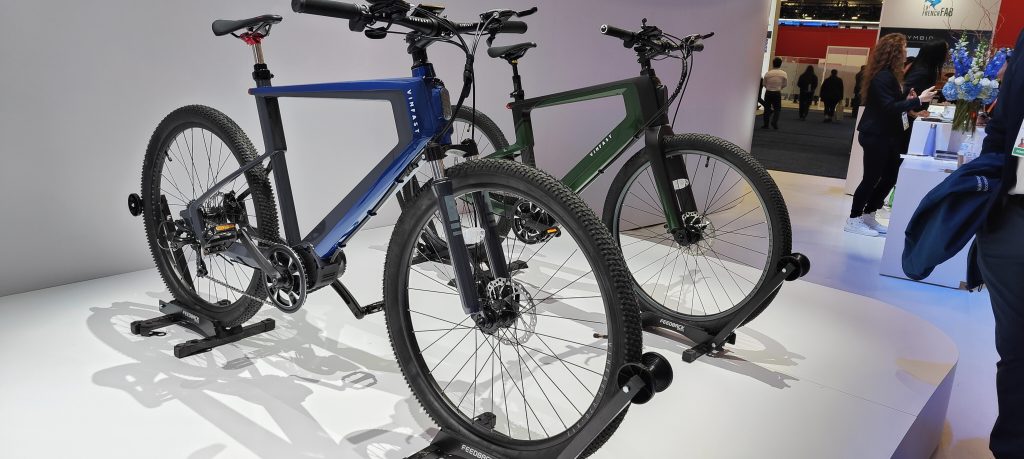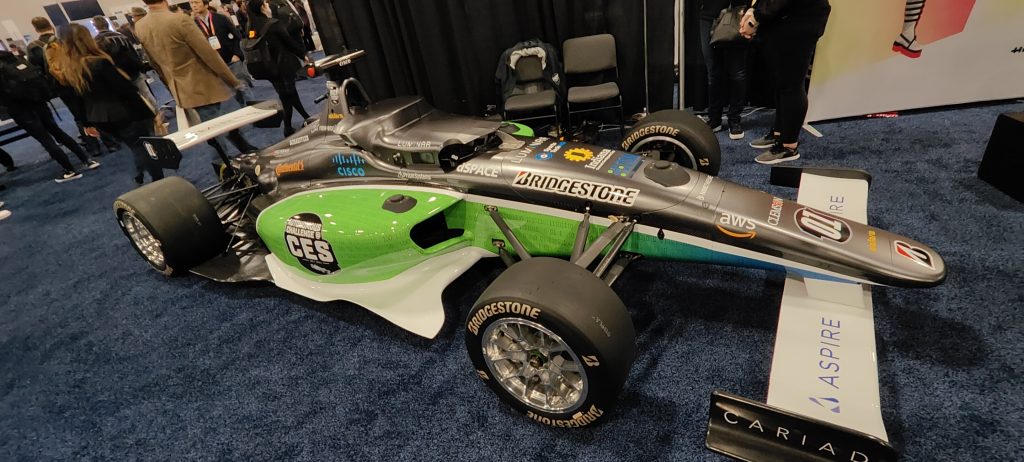Five years ago, CES had become a locus for self-driving vehicle demonstrations with autonomous vehicles cruising down the Las Vegas Strip drawing stares from passersby. In the post pandemic world, CES mobility exhibits came back down to earth, focusing less on experimental autonomous vehicles and more on the rapid shift away from combustion engines to fully electric cars and trucks. Even consumer electronics and tech companies like Sony and Amazon were more focused on electric vehicles (EVs) and the in-car experience.
“Car makers are leading efforts to lead a greener and more sustainable future,” said Gary Shapiro, CEO of the Consumer Technology Association, at a keynote address featuring auto giant Stellantis. Indeed, consumers seem to agree.
Just a couple of years ago, market analysts predicted EVs would only account for less than 2 percent of car sales today. However, early survey results for last year indicate that 10 percent of new car sales in 2022 were electric, according to LMC Automotive and EV-Volumes. Worldwide, sales of electric vehicles topped 7.8 million units, which is a 68 percent increase over 2021.
Still, there continues to be a voracious appetite for traditional pickup trucks in the U.S. Last year, the top three vehicles sold in the U.S. were pickups, according to Edmunds. So considerable fanfare surrounded Stellantis’ big reveal of its RAM 1500 Revolution battery-powered electric pickup concept at CES 2023.
The RAM Revolution is a fully Web-connected vehicle (replete with remote retail opportunities) and boasts a host of slick design elements including a removable center console and opposing doors that open without the obstruction of a center pillar divider between the front and back seats. The pickup will also use a faster-than-Tesla 800-volt charging system that can deliver 100 miles of range in less than 10 minutes.
Few additional details were available on the concept RAM Revolution truck, which is expected to appear in showrooms next year. But Stellantis will be playing catch up in a field that already includes Ford’s F-150 Lightning, the Rivian R1T, and the GMC Hummer EV. With demand for EVs far outstripping supply, however, Stellantis expects to still be in the mix when the RAM Revolution finally goes on sale.
Meanwhile, traditional luxury brands have been playing catchup to Tesla. Mercedes-Benz, more recognized for its engineering prowess than its aesthetic sensibilities, made a point of showing off a (finally) attractive design, its Vision EQXX research vehicle. The Vision EQXX looks like a throwback to James Bond’s 1968 Aston Martin but under the hood it’s all-electric and capable of traveling 745 miles on a single charge. Mercedes is hoping to couple such skills with a new in-cabin consumer electronics experience using Dolby Atmos and Apple Music and Universal Music to deliver the ultimate in immersive sound.
More significantly, Mercedes-Benz made news at CES by announcing it would launch its own network of public Mercedes-branded charging stations, which is clearly taking a page from Tesla and will no doubt be dotted near many retail stores. The network will be built in partnership with ChargePoint, and Mercedes said its North America network will include more than 400 hubs with more than 2,500 high-power chargers crisscrossing the continent by 2027. One feature touted at CES was that Mercedes owners will be able to reserve charging stations remotely from their car, although the stations—unlike Tesla’s—will be open to all EV owners.
However, happiness may be never having to stop for a charge—or almost never. Lightyear, a Dutch company that already makes a $300,000 EV that’s wrapped in solar panels to add extra miles, debuted a new solar EV model that the company promised would have a range of 500 miles and cost less than $40,000.

In-Car VR
Also wrapped in special panels, BMW once again showed off its i Vision Dee concept car, a sedan that rolled out onstage in white but then generated applause when it flipped through some of its 32 owner-adjustable exterior colors, thanks to Dee’s E Ink technology. Dee stands for digital emotional experience, and BMW also stressed the interior virtual reality and mixed reality experience it plans to give owners in the future.
Hoping to maintain and expand its own presence in car dashboards, Sony touted its future gaming and in-cabin VR experiences. At CES the company in partnership with Honda debuted its Afeela concept vehicle, an electric car with immersive in-car entertainment. The spinoff company, Sony Honda Mobility, plans to start selling the car in 2026.
“Afeela represents our concept of an interactive relationship where people feel the sensation of intelligent mobility and where mobility can detect and understand people and society by utilizing sensing and AI technologies,” said Sony Honda Mobility chairman and CEO Yasuhide Mizuno in explaining the concept behind the name.
Gaming and the so-called metaverse was also on the minds of other CES mobility exhibitors. One company, Holoride, introduced a new VR service package designed to eliminate car-trip “Are we there yet?” boredom–without having to buy a new car. Using existing VR headsets and its Holoride GPS/wireless add-on, the system allows wearers to play games, surf the Web, or binge watch shows without inducing motion sickness.
“I can’t read or watch TV in a car,” explained co-founder Daniel Profendiner riding in the back of 1967 Cadillac convertible as he demonstrated the service to Dealerscope. “But I can watch this because the view moves in sync with the car.”

Ebikes Riding a Wave
Other mobility exhibits continued to make inroads at CES 2023, with ebikes dominating. As demonstration of their popularity, Vietnamese car maker Vinfast displayed a line of ebikes as did some CE brands. Using the RCA moniker—more associated with the era of VCRs and Nipper the dog—a new line of ebikes with the brand embossed of their frames debuted with models for country trails as well as suburban commuting.
Even supercar maker Bugatti is in the emobility market, touting its second-generation electric scooter at CES. But while the Bugatti Chiron Super Sport 300+1 sports car has a top speed of just under 305 mph, Bugatti’s new e-scooter tops out at just 22 mph.
Naturally, the mobility trend has not escaped the purview of e-tail giant Amazon. The company hopes to leverage Alexa in cars, announcing at CES that it’s adding a new service that allows Alexa to locate charging stations for EV drivers, for example. Amazon also threw its Ring brand into the dashcam arena with the $250 Ring Car Cam. The device not only monitors drives but will also monitor cars while parked—for a monthly fee of $6 or $60 for the year. Many CES attendees expected the Ring Car Cam to reignite interest in dash cams in general.

Autonomy Still Coming
Based on what was on display at CES 2023, autonomous vehicles are still coming…just much more slowly to market than anticipated and probably led by the commercial sector rather than in consumer cars. The big kahuna in this space is still Google’s Waymo, and some of its vehicles festooned with lidar and camera technology were on display at the show. Even though Waymo’s technology is more advanced than any other company in this space, aside from some still-experimental robotaxis in San Francisco and Phoenix, its vehicles still haven’t hit the consumer market.
In fact, the focus of self-driving technology has shifted more to the industrial and commercial use of autonomous vehicles. For example, Ouster’s lidar technology is now being used by companies like Outrider in autonomous vehicles designed for shipping yards. And big industrial and agra brands were touting autonomous tech, as well.
Caterpillar went big, indeed, with its 100-ton Cat 777 dump truck on display. One of the largest autonomous vehicles on the planet, the truck is one of some 550 trucks Caterpillar says are now operating autonomously around the world. Aside from demonstrating its mining and construction tech, Caterpillar underscored it has a deeper connection to CES.
“We help miners unearth materials found in everything from the smartphone displays to batteries for electric vehicles that are exhibited at CES,” said Marc Cameron, a Caterpillar senior vice president.
Across the aisle at CES 2023 agricultural equipment company John Deere also had some heavy machinery on display. The highlight of the company’s exhibit was a tractor with sprawling 120-foot-wide booms dotted with 36 cameras. It was part of the company’s See and Spray rolling computer system, which can tell the difference between plants and weeds and only spray herbicide on the later. The system can reduce the use of herbicides by up to 66 percent, which is good for the environment, and reduce stress on crops, which improves yields.
Also on display at CES was a new John Deere electric excavator. It not only boasts zero emissions but also lower maintenance costs for construction sites, as well as reduced noise pollution at job sites.
All of this attention focused on commercial technology applications is not to say that researchers aren’t still racing to bring autonomous vehicles into the consumer space. In its second year at CES, the Indy Autonomous Challenge race took place on the penultimate day of the show at the Las Vegas Motor Speedway. Nine teams programmed Indy open-wheel race cars outfitted with autonomous sensors and controls to run at speeds of up to 180 mph. The winner this year was the PoliMOVE team from Politecnico di Milano and the University of Alabama.
And finally, if it’s CES in Las Vegas, there has to be a flying car. What was different this year is that many believe Aska might actually get its model off the ground. The company has been building its carbon fiber prototype of the A5 out in Mountainview, Calif., explained COO and co-founder Maki Kaplinsky. With its wings and propellers folded back, the A5 can handle road work, and then extend its wings for either vertical or short takeoffs and landings.
The Aska A5 is expected to cost $789,000 (they are taking preorders now). The vehicle is electric, has a 250-mile range (or 110 minutes of flying time) and an airspeed of 110 mph. It also boasts the latest Garmin pilot and navigation systems, and Kaplinsky expects it to be the first drive-and-fly vehicle to be approved by the FAA.
The spate of storms out West damaged the A5 on its way to CES, so we weren’t able to get a ride-along demonstration. “But we hope to start fly testing in Q1,” Kaplinsky told Dealerscope. So we’ll have to wait until next CES to get our flying car ride.















